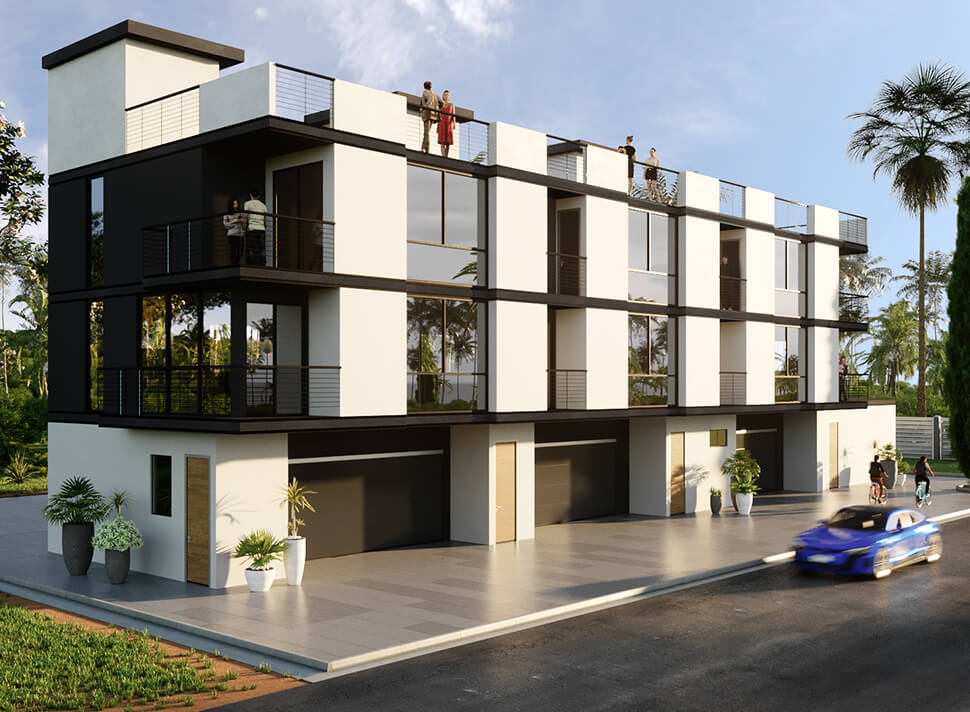What Is 3D Exterior Rendering Used For
Technology has created new and innovative aspects in the field of architecture. Architects can create, design, and faster implement the ideas of building architectural structures. All the paperwork has smoothly transitioned to digital mediums.
Technology also provided new avenues for the visualization of yet-to-be-constructed structures. One such avenue is 3D exterior rendering.

Image from Yousee Studio
3D exterior rendering displays high-resolution pictures of architectural structures. These 3D pictures are realistic and beautiful. The rendering provides a visual and realistic feel of the final project to the client. This service gives a vision of the final structure and its surroundings. Involved people will get a better idea about the scale of the project.
The process of 3D exterior rendering is done using various computer softwares.
What Is 3D Exterior Rendering and What Is It Used For?
3D exterior rendering involves creating three-dimensional images from a 3D model of the project. The environment and surrounding factors are also considered.

Image from Yousee Studio
An architectural project is a complex affair right from when it starts. An architect needs to ensure that every detail is as per the client’s requirements. Any rework or changes much later in the process can be highly stressful and prove to be costly.
3D exterior rendering is a definitive way to provide your client with a visual blueprint. It shows how the entire project will look once it is completed.
Clients can visualize the end project since the images are realistic and have high resolution.
The 3D exterior model can enable your client to view:
- The building from all angles
- How the building or the structure will look like with its surrounding environment, all in great detail
This facilitates communication between the architect and the client. Any requirements, expectations, and modifications can be discussed easily.
Advantages of 3D Visualization over 2D Designs:
A 2D design or sketches don't have the same effect as a 3D model on the client.
3D exterior rendering helps your client better understand the impact of surroundings better. This includes the aesthetics and the finishing colors. This is because the exterior rendering is photorealistic.
This way clients can take an informed decision before they go ahead in investing their hard-earned money.
In addition to this, it is also used by architects, builders, planners, and marketers. They can pitch their ideas to prospective clients.
Types of 3D Exterior Renderings
Broadly speaking, exterior renderings come under two categories:
- Still 3D Renders
Still exterior renderings will depict static images of the project with its exteriors. Your clients can view various static photos of the project from different angles.
- Animated 3D Renders
Animated exterior renderings are digitally enhanced videos of the architectural project. They give a more comprehensive view of the exteriors of the project by including the surroundings.
These renderings are also made more realistic using augmented reality and virtual reality.
Benefits of 3D Exterior Rendering in the Design Process
3D rendering is helpful at various stages of project development.
During the initial stages, renderings can help both the design team and the clients. They can align their basic requirements.
During the later stages, it can help the clients with finalizing specifics like colors and materials.
- Displaying the Basic Structure
This is the primary objective of any 3D exterior rendered image. It gives a basic outline of how your completed structure and room will look from the outside.
This includes how the project will look from various places like:
- How the project will look from the front
- Aerial view of your project
- Integration of your structure with the surroundings
This basic rendering will help your client to understand how the structure will look overall.
- Showcasing the Color Palette
Do you know the main objectives of 3D exterior rendering? It is to give a realistic feel of the completed project to the client. This involves depicting with as much precision what the end result will look like.

Image from Yousee Studio
You can use various color combinations on exterior 3D renderings. This will allow your customers to see what certain colors will actually look like.
This will eliminate the burden of planning and trying out different samples of colors on the end structure.
- Switching With Different Material Combinations
Along with colors, the use of various materials can be a dilemma for clients. 3D exterior renderings can help them decide on the use of preferred materials. Clients can determine this for the best aesthetic views of their properties.
For example, you can easily switch the materials displayed to the client in the rendered images. Switch the materials from concrete to wood or whatever the client likes. This is crucial for comparative analysis.

Image from Yousee Studio
- View in Various Lightings
With 3D exterior rendering, your client doesn't need to image his project in different light settings. You can create a render for the project in daylight, daybreak, sunset, and nighttime.
It also covers certain weather conditions like a bright sunny day or a heavy gray cloudy day.
An exterior rendering will give a good depiction of your project’s view in all weather and lighting. So, your client can choose the right color combination that goes with the lighting conditions and the exteriors.
- Working on Minute Details
Secondary minute details can also affect the way your overall structure looks once completed. These details include components like fixtures, window panes, and door frames.
A good 3D exterior rendering model showcases how these features and elements look on the completed project.
Based on these renderings, the client can pick combinations from a plethora of solutions. This will help them make their homes, or commercial structures visually appealing. Minute details can be made visible before the construction process.
- Risk Mitigation
No project is free of any risks. A visual 3D exterior rendering will help identify any risks in the project. There is a potential for risks to arise post the completion of the architectural structure. It helps reduce any technical mistakes that arise due to miscommunication.
- Preventing Huge Expenses
Using 3D exterior renderings is a cost-effective mechanism. Changes in design and minor or major fixes can be done before the actual structure is created. This prevents any late reworks which can incur heavy costs.
How to Make a 3D Exterior Rendered Model?
The purpose of a 3D exterior rendered model is to simulate the end project. Clients should get an external environmental context. To achieve this, the model needs to be as realistic as it can look.
There are several tools that are used for rendering purposes. Below are some guidelines to achieve a photorealistic experience of 3D exterior renderings.
- Details and Data
Before a 3D exterior model is made, the client needs to communicate. He should share and submit all the information. This includes their needs and requirements in excruciating detail. The render artist should ask all questions in this phase.
Along with this, the render artist needs to access basic architectural sketches, 2D drawings, blueprints, and site plans. This information should be available to come up with realistic and much more accurate 3D renderings.
During this initial stage, it is also important to finalize the file formats to be used in the project. Along with this, how long the entire process of rendering will take should also be discussed. This will prevent any confusion and compatibility issues going further. Thus, it makes the whole construction or renovation task smoother.
- Using a High-Quality 3D Model
Detailed designs and sketches can help to superfine the 3D exterior rendering. A good 3D model should be based on sketches and important documents. It will highly improve the quality of 3D exterior rendering.
- Good Photographs
Good site photographs of the site are crucial for render artist. They can help the render artist to depict an almost accurate depiction of the exterior background. This helps with presenting a realistic 3D exterior rendering. Good photographs are a key to great rendering products.
- Realistic Backgrounds
Simulate the project in all seasons and at different times of the day. Check out the project appearance in different months like January, July, etc. This will help achieve a better understanding of the background.
- Use of Correct Lighting
A good 3D exterior rendering will take into account various angles of light that will hit it. A good projection will produce realistic images under various light settings. Apart from this, it will also show their impacts like reflection, refraction, and their effects on the final project.
- Use of Appropriate Textures
Good quality textures are necessary for giving a full-blown effect of the final 3D exterior rendering. The higher the quality of the texture used, the better it will map to the environment and the final image.
Ensure to use the right texture map property settings while using the textures you are using as well.
Importance of 3D Exterior Visualization
Check out the importance of 3D exterior visualization for different roles.

Image from Yousee Studio
Homeowners and Customers
Homeowners and customers are more visual in their needs. It is easier for them to understand their needs from a 3D exterior rendering image. This cannot be achieved with bland 2D sketches or architectural blueprints.
These renderings will also help them communicate their ideas of how their homes or architectural structures should look. Clients can communicate in simple language without any technical jargon needed.
Architects
Architects benefit the most from using 3D exterior renderings. It helps them at all the development stages of the project right from the conception of the structure. The project can be a house or office, doesn’t matter!
3D exterior renderings help the architects learn whether they and the customer are on the same page. A 3D exterior model will help the customer to communicate their needs and requirements from time to time.
They can request changes for the final structure under various conditions. They may have different preferences for color or textures.
Builders
Builders need to understand thoroughly the various layouts and structural design specifications. Once this is clear, only then they can go ahead with actually building the structure. Structural changes are costly and waste a lot of resources.
Therefore, ensuring that the requirements are well understood beforehand is of extreme importance.
3D exterior renderings can be used as a frequent reference by builders. The renderings can assist them to understand the needs of the end design and work accordingly. These renderings will assist the builders in their job.
Real Estate Agents
No doubt location is the key to the real estate business. But, a good 3D exterior rendering will boost the prospects of a sale. It will help the citizens be sure about their decisions making the project look extremely professional.
Real estate managers can use 3D exterior renderings for marketing and advertising.
They can pitch their sales by making their customers visualize what the structure will look like post-completion. With attractive designs, agents can justify the rates that they have set.
Large Organizations
Large organizations and companies have gigantic architectural projects with huge spaces. Their business revolves around pitching their ideas in the most effective manner to the investors. It is difficult to communicate the grandiosity of the structural designs through 2D drawings.
3D exterior renderings create lucid communication during the sales pitch. Renderings can eliminate any doubts or queries about the original structural view. These doubts that may arise in the future.
Software for 3D Exterior Rendering
Following are some of the common software tools used to create and store 3D exterior renderings. As per the expertise of the artist, animations can also be added.
- SolidWorks
- 3D Studio Max
- V-Ray
- SketchUp
- Autodesk Maya
- Photoshop CS
- CATIA
- KeyShot
- Rhinoceros
Conclusion
3D exterior rendering provides clarity at all stages of the architectural project development. The entire team gets a bird’s-eye-view of the amalgamation of the entire structure with its exteriors.
These renderings have proved to be an effective way of communicating the requirements, needs, and corrections. This eliminates huge expenditures in a speedy and effective manner.
Contact us at YouSee Studio for captivating 3D renderings and immersive virtual experiences.
Ray Lisbon is a content writer and the author of this article.


